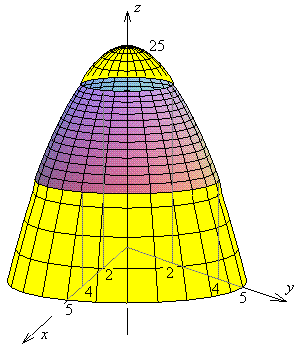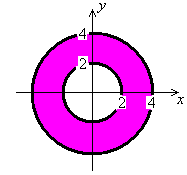ENGI 5432/5435 Advanced Calculus
Faculty of Engineering and Applied Science2008 Winter
Term Test 2 - Solutions
[Chapter 2]For the vector function
 in the x-y plane:
in the x-y plane:- By establishing that there are no singularities of
 in the simply connected domain
in the simply connected domain
 =
{ all (x, y) closer than 2 units to the
point (2, 2) }, show that Green’s theorem is valid on
=
{ all (x, y) closer than 2 units to the
point (2, 2) }, show that Green’s theorem is valid on
 .
.
The vector function
 is obviously well-defined (and infinitely
differentiable) everywhere except the origin.
is obviously well-defined (and infinitely
differentiable) everywhere except the origin.
The distance of the origin (0, 0) from the point (2, 2) is
The only singularity is outside .
.
Green’s theorem is therefore valid everywhere on .
. - Hence evaluate
 , where C is
one complete circuit around the circle in the x-y plane,
centre (2, 2), radius 1, (which is entirely inside the
domain
, where C is
one complete circuit around the circle in the x-y plane,
centre (2, 2), radius 1, (which is entirely inside the
domain  ).
).
Green’s theorem
![[Green's theorem]](t2/q1b1.gif)

everywhere in the domain, including within C .


[The direct evaluation of the line integral is very difficult and should be avoided!]
- By establishing that there are no singularities of
For the vector field
 :
:- By evaluating curl
 , show that a potential function
, show that a potential function
 exists on all of
exists on all of
 3.
3.

Therefore is irrotational everywhere and a potential function
exists.
is irrotational everywhere and a potential function
exists. - Find the potential function
 that is defined in such a way
that the potential is zero at the origin.
that is defined in such a way
that the potential is zero at the origin.
The potential function
 is such that
is such that

![[integrate partial dphi/dx]](t2/q2b2.gif)
where f (y, z) is an arbitrary function of integration
![[match partial dphi/dy]](t2/q2b3.gif)

where g (z) is another arbitrary function of integration
![[match partial dphi/dz]](t2/q2b5.gif)
The potential function is therefore

where C is an arbitrary constant of integration.
However, we require that the potential be zero at the origin:

The potential function is therefore
- By evaluating curl
A sheet is in the shape of that part of the circular paraboloid
 that lies between the circular cylinders
that lies between the circular cylinders

The sheet has a surface density of
- Determine the total mass of the sheet.
Let r2 = x2 + y2 then the equation of the circular paraboloid becomes
z = 25 - r 2.
Use the parametric grid (r, q), such that


The ranges of the parameters are 2 < r < 4 and 0 < q < 2p.
The tangent vectors along the coordinate grid lines are

A normal vector to the surface at every point is



![[evaluating integrals]](t2/q3a6.gif)

- Locate the coordinates
 of the centre of mass of the sheet.
of the centre of mass of the sheet.
By symmetry,

Taking moments about the x-y plane,



Therefore the centre of mass of the sheet is located at
[Note that the centroid is located exactly half way between the bottom and top of the sheet. As z increases, the decreasing surface area compensates exactly for the increasing surface density.]
An alternative solution, using the projection method, is available from this link.
- Determine the total mass of the sheet.